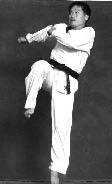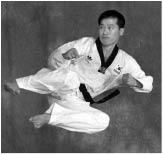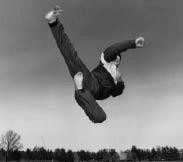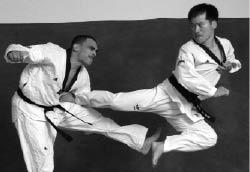Complete Kicking (21 page)
Authors: Turtle Press

2. Step forward and take as many steps as you need to pace yourself.
3. At the point of jumping, pivot your body 180° and elevate your torso as high as you can, while raising your kicking knee to chest level.
4. Just before reaching the peak of the jump, bring both knees close to your body and let your compact body “fly” toward the target.
5. At the peak, snap your primary foot out in a side kick. Keep your other leg tucked in close to your buttocks to augment the flying momentum.
Upward flying side kick is more advanced than conventional side kick and requires outstanding flexibility and strength of the leg muscles. The torso leans back more than horizontal flying side kick to allow the kicking leg to strike upward.
applications
Flying side kick is powerful because it delivers the weight of the entire body, which is propelled by the momentum of running and jumping. When used with control and coordination, it can knock an opponent to the ground. Flying side kick requires a long approach, so it is more commonly used for demonstrations and board breaking than in practical applications.
A short flying side kick against a lunging opponent can take his breath away and establish dominance.
Flying side kick is an excellent technique for demonstrations and board breaking. Practice in front of mirror to create a proper form and with a light target (such as a handheld target) to develop accuracy.
* When executing a flying side kick without a firm target to strike, for example in a demonstration, jump, extend your leg and hold it in the air rather than kicking to full extension. Putting too much power in a flying side kick without a proper target to absorb the impact can result in joint injuries.
PERFECTING YOUR FORM
• Build strong muscles in the legs through squats, lunges and jumping drills.
• Strengthen the stomach muscles with sit-ups and crunches.
• Jump rope or run in sand to strengthen your knees and ankles.
• Practice running rhythmically and jumping after a consistent number of steps.
• Align your body in a triangular shape (head, kicking foot and supporting knee as shown below) at the peak of your jump.
common mistakes
The most common mistake occurs in jumping—either in lowering the torso to the side or rushing the sequence of movements. To correct this, follow a natural sequence: run to pick up momentum, lift your rear knee forward as high as you can, pivot your torso using the momentum of the rising knee, stretch the kicking leg toward the target while bringing up the supporting leg up. Begin from a low jump and build up in height. Be sure to build your leg strength sufficiently before attempting this kick.
• remember
1. Elevate your torso first.
2. Raise your kicking knee high.
3. Pivot your body to the side and align your torso and legs on one plane.
4. Make your body compact while in the air and unfold it when kicking.
• avoid
1. Jumping too far or too high
2. Dropping your non-kicking leg
3. Rushing your jump or kick
4. Kicking with too much power
5. Lowering your torso to the side or rear
6. Opening your arms too wide
SPINNING & TURNING KICKS
The spinning and turning kicks in this section are based on what you have learned so far. Spinning or turning kicks involve quick rotation of the body while maintaining proper form.
Three important elements for successful spinning kicks are focus, balance and agility. Focus is enhanced by spotting the target before and after turning your body and following a direct kicking path to the target. For balance, keep your center of the gravity lower than normal and stay relaxed. For agility, concentrate on moving intuitively rather than analytically. To succeed, be in tune with your natural awareness rather than worrying about your mistakes.
BACK KICK
purpose
In competition back kick is very often used for counterattacking against roundhouse kick or as a surprise attack. Back kick’s power comes from the rotation of the body, however deceptive execution adds to the kick’s effectiveness. Since turning the body is risky, you should spot the target immediately after turning and be on guard at all times.
key points
Start from a sideways stance to reduce the initial movement of your body and initiation time. Rotate your hip first and then throw your foot directly to the target, delivering your entire bodyweight, which is magnified by the spinning motion.
striking area
Blade, bottom of the foot, ball, heel
targets
1. abdomen
2. solar plexus
3. neck
4. face
5. kidney
Other books
Passion Sails at Sea (Diary of a Free Woman) by Thorne, Diane
Seduced by Chocolate by Celia Kyle, Lizzie Lynn Lee
Salvation (The Captive Series Book 4) by Stevens, Erica
Looking At Forever (The Rock Gods Book 4) by Ann Lister
The Sunset Prophecy (Love & Armageddon #1) by Day, P.J.
The Wand-Maker's Debate: Osric's Wand: Book One by Albrecht Jr., Jack D., Ashley Delay
An Infinite Sorrow by Harker, R.J.
Reaching First by Mindy Klasky
The Fringe Worlds by T. R. Harris
Beneath The Surface by Glenn, Roy







